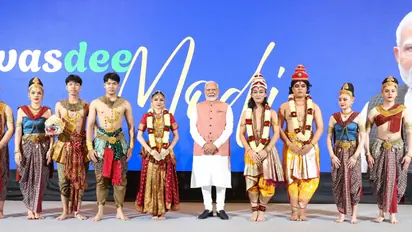How ‘Act East’ redefined India's regional diplomacy under PM Modi | Explained

Synopsis
The Act East Policy has emerged as a central pillar of Prime Minister Modi’s foreign policy, enhancing India’s strategic, economic, and cultural engagement with Southeast Asia and the Indo-Pacific.
Over the past decade, Prime Minister Narendra Modi’s foreign policy has demonstrated unprecedented dynamism, none more so than through the transformation of India’s Look East Policy into the more action-driven Act East Policy (AEP). The policy has reshaped India’s engagement with Southeast Asia and the broader Indo-Pacific, positioning the country as a vital strategic player in the region.
From Look East to Act East: A Strategic Shift
Originally introduced in 1992, India’s Look East Policy aimed at strengthening economic ties with Southeast Asia. However, with changing geopolitical realities, PM Modi revitalized the approach in 2014 by launching the Act East Policy. Unlike its predecessor, the AEP brought a more results-oriented framework, focusing not only on trade but also on strategic, cultural, and diplomatic partnerships.
Sustained High-Level Engagements in the Region
PM Modi has led from the front, visiting nearly all key ASEAN nations to deepen bilateral ties. Noteworthy visits include:
- Singapore (2015, 2018, 2024): Strengthened fintech and economic collaboration
- Indonesia (2018, 2022, 2023): Expanded maritime security cooperation
- Philippines (2017): First Indian PM visit in 36 years, reinforced ASEAN security links
- Brunei (2024): First-ever visit by an Indian Prime Minister
- Republic Day 2018: All ASEAN leaders were invited as Chief Guests to mark 25 years of ASEAN-India Dialogue Partnership
PM Modi has also visited Myanmar, Malaysia, Thailand, Laos, and Vietnam, demonstrating India’s growing diplomatic outreach in the region.
Robust Economic Partnerships and Infrastructure Push
Under Modi’s leadership, India-ASEAN trade almost doubled, rising from USD 71 billion in 2016-17 to over USD 130 billion in 2024. Today, ASEAN stands as India’s fourth-largest trading partner, while India ranks seventh for ASEAN.
To bolster connectivity and trade:
- The India–Myanmar–Thailand Trilateral Highway is being developed
- Projects like the Agartala-Akhaura railway, linking Northeast India with Bangladesh, have been fast-tracked
- Direct flight connectivity with several ASEAN nations has improved, boosting trade, tourism, and cultural exchange
Also read: From Bangkok to Bodh Gaya: How PM Modi is weaving Buddhism into India's foreign policy
Strategic and Security Cooperation Gains Ground
Defense cooperation under the Act East Policy has seen major strides:
- BrahMos missile deal with the Philippines marked India’s entry into the regional defense export market
- Military logistics agreement with Vietnam enhances India's naval footprint in the Indo-Pacific
- The Indo-Pacific Oceans Initiative (IPOI), launched in 2019, strengthens maritime security and promotes freedom of navigation
- India-ASEAN joint maritime exercise in 2023 showcased India’s commitment to regional security
Cultural Diplomacy and People-to-People Ties
Beyond economics and defense, cultural engagement remains a cornerstone of AEP:
- Shared Buddhist heritage with countries like Myanmar, Thailand, Laos, Vietnam, and Indonesia has been highlighted
- Over 300 ASEAN students have received scholarships to study at Nalanda University
- The growing popularity of International Yoga Day in Southeast Asia reflects India’s expanding soft power
Expanding Collaboration in New Sectors
India and Singapore have taken the lead in fintech cooperation, with Singapore becoming the first country to establish fintech connectivity with India.
During the COVID-19 pandemic, India extended vital medical assistance to ASEAN nations, underscoring its commitment to regional health security.
India: The First Responder in Times of Crisis
India’s proactive humanitarian outreach further demonstrates its leadership:
- Sri Lanka (2022-23): India extended $4 billion in aid and helped secure a $2.9 billion IMF bailout
- Nepal Earthquake (2015): Operation Maitri launched swiftly for rescue and relief
- Afghanistan (2018): 1.7 lakh tonnes of wheat and 2,000 tonnes of Chana Dal sent during a severe drought
Impact of the Act East Policy
A decade since its launch, the Act East Policy has transformed India from a regional observer to a regional leader. Unlike the earlier Look East Policy, AEP encompasses a 360-degree engagement approach—diplomatic, strategic, economic, and cultural.
India’s assertive presence in Southeast Asia and the Indo-Pacific reflects PM Modi’s larger vision of a self-reliant, strategically influential, and globally engaged India.
Stay updated with the Breaking News Today and Latest News from across India and around the world. Get real-time updates, in-depth analysis, and comprehensive coverage of India News, World News, Indian Defence News, Kerala News, and Karnataka News. From politics to current affairs, follow every major story as it unfolds. Get real-time updates from IMD on major cities weather forecasts, including Rain alerts, Cyclone warnings, and temperature trends. Download the Asianet News Official App from the Android Play Store and iPhone App Store for accurate and timely news updates anytime, anywhere.